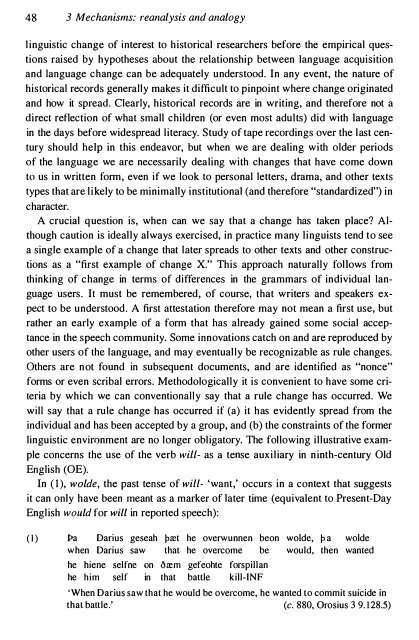Gram - SEAS
Gram - SEAS
Gram - SEAS
Create successful ePaper yourself
Turn your PDF publications into a flip-book with our unique Google optimized e-Paper software.
48 3 Mechanisms: reanaLysis and anaLogy<br />
linguistic change of interest to historical researchers before the empirical questions<br />
raised by hypotheses about the relationship between language acquisition<br />
and language change can be adequately understood. In any event, the nature of<br />
historical records generally makes it difficult to pinpoint where change originated<br />
and how it spread. Clearly, historical records are in writing, and therefore not a<br />
direct reflection of what small children (or even most adults) did with language<br />
in the days before widespread literacy. Study of tape recordings over the last century<br />
should help in this endeavor, but when we are dealing with older periods<br />
of the language we are necessarily dealing with changes that have come down<br />
to us in written form, even if we look to personal letters, drama, and other texts<br />
types that are likely to be minimally institutional (and therefore "standardized") in<br />
character.<br />
A crucial question is, when can we say that a change has taken place? Although<br />
caution is ideally always exercised, in practice many linguists tend to see<br />
a single example of a change that later spreads to other texts and other constructions<br />
as a "first example of change x." This approach naturally follows from<br />
thinking of change in terms of differences in the grammars of individual language<br />
users. It must be remembered, of course, that writers and speakers expect<br />
to be understood. A first attestation therefore may not mean a first use, but<br />
rather an early example of a form that has already gained some social acceptance<br />
in the speech community. Some innovations catch on and are reproduced by<br />
other users of the language, and may eventually be recognizable as rule changes.<br />
Others are not found in subsequent documents, and are identified as "nonce"<br />
forms or even scribal errors. Methodologically it is convenient to have some criteria<br />
by which we can conventionally say that a rule change has occurred. We<br />
will say that a rule change has occurred if (a) it has evidently spread from the<br />
individual and has been accepted by a group, and (b) the constraints of the former<br />
linguistic environment are no longer obligatory. The following illustrative example<br />
concerns the use of the verb wiLL- as a tense auxiliary in ninth-century Old<br />
English (OE).<br />
In (I), waLde, the past tense of wiLL- 'want,' occurs in a context that suggests<br />
it can only have been meant as a marker of later time (equivalent to Present-Day<br />
English wouLd for wiLL in reported speech):<br />
(I) l>a Darius geseah pa:t he overwunnen beon wolde, pa wolde<br />
when Darius saw that he overcome be would, then wanted<br />
he hiene selfne on- 6a:m gefeohte forspillan<br />
he him self in that battle kill-INF<br />
'When Darius saw that he would be overcome, he wanted to commit suicide in<br />
that battle.' (c. 880, Orosi us 3 9. 1 28.5)
















